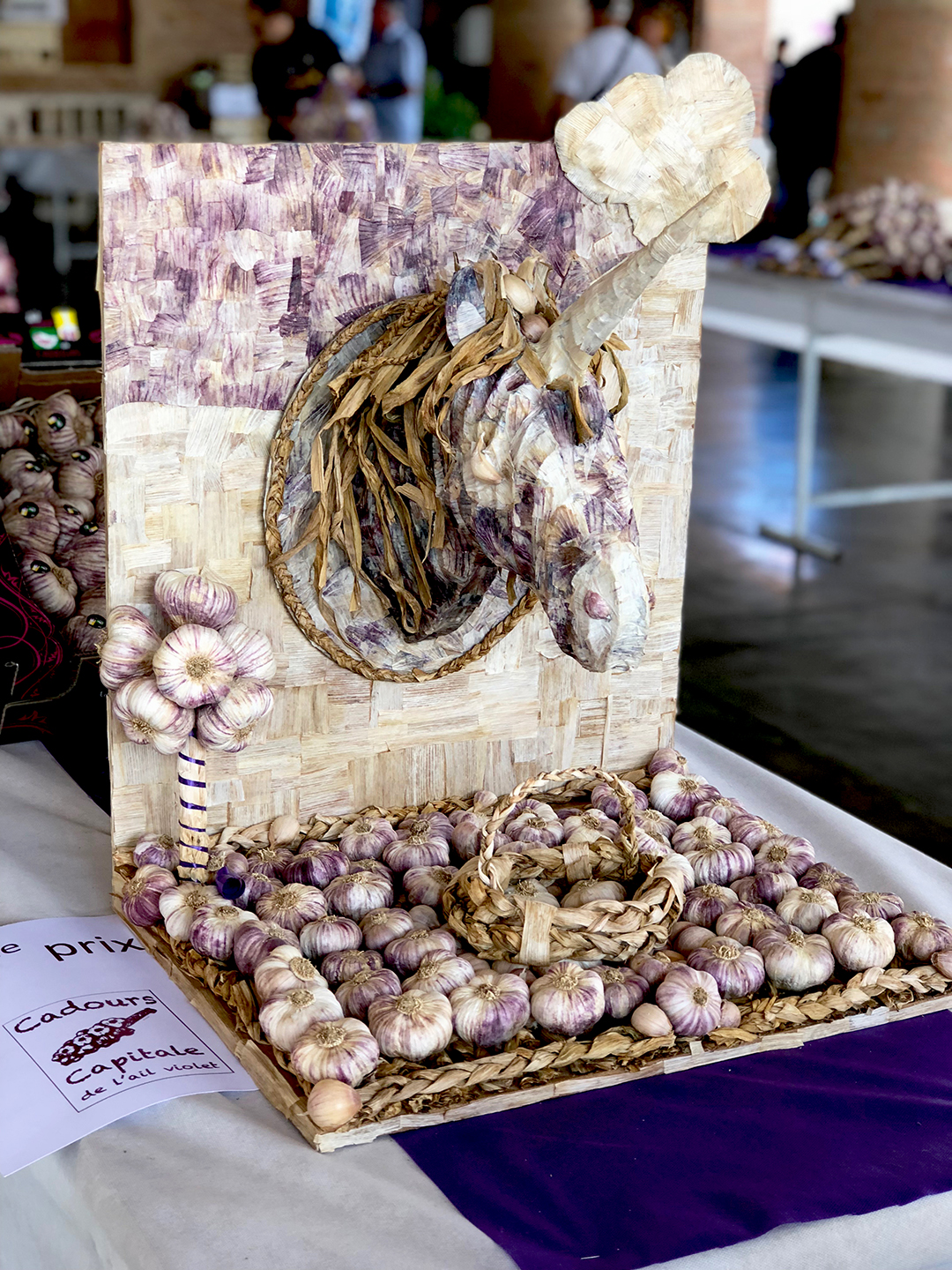I’m pretty sure I got my first taste of garlic when my grandmother made her famous pommes de terre sarladaises: she sautéed scalloped potatoes with duck fat in her cast-iron Dutch oven, crusted by decades of faithful service. Toward the end of the cooking time, she’d throw in a generous quantity of slivered garlic and a handful of chopped parsley. If we were lucky, golden chanterelles were combined with the potatoes. The whole kitchen smelled of garlic.
Bunches of garlic are hung to dry under la halle in Cadours
She also served a soupe au pain every night where thick slices of country bread soaked in a flavorful garlicky broth. More often than not, it also included vegetables from the garden: cabbage, carrots, dried fava beans… It was a far cry from the elegant potages served in Paris restaurants! When vegetables were not available, farmers would simply make a tourin blanchi, a garlic soup bound with an egg. It truly earned the nickname of soupe du pauvre. It’s simple, rustic, and unexpectedly smooth.
The stalks of this purple garlic are soft enough to be braided
Just a few weeks ago, Rick and I drove to Cadours, a small village of Haute-Garonne, during their annual Fête de l’Ail Violet. It was the perfect opportunity to get acquainted with their AOP purple garlic, witness how it is peeled and braided, and sample some tasty garlic soup.
A peacock entirely made of garlic was awarded First Prize this year.
Another surprise: a contest featuring stunning models completely made of garlic –cloves, skins, stalks– and displayed under the imposing 19th-century brick halle. Not as old as la halle de Grenade but a nice piece of architecture nonetheless.
I can’t even imagine how many hours were spent to recreate the Cadours church in garlic
I confess that I was not familiar with this purple garlic from Cadours: it only earned its Appellation d’Origine Protégée in 2017. But it prompted me to do some research on French varieties of garlic beyond the generic “white” variety.
Quite a trophy!
Three varieties of garlic have been awarded some distinctive protections.
Ail Rose de Lautrec IGP is the most famous one. This high-quality pink garlic is grown in the Tarn near Albi and obtained its Indication Géographique Protégée in 1996. It has a subtle and slightly sweet taste. It is said to keep for a full year.
Ail Violet de Cadours AOP exhibits a notable purple color on the skins. The heads are fairly large. The aroma and flavor assertive. In hot preparations, some sweetness balances its strength. It’s marketed as early as July, before any other French garlic.
Ail Fumé d’Arleux IGP is a pink garlic cultivated in the Hauts de France (the old Nord-Pas de Calais region.) It’s braided then smoked. The process gives the heads a copper color and confers a woody note to the garlic.
A little bit of Franglais…
If you love garlic, you’d probably enjoy going through a blind tasting to compare white, pink and purple garlics: make several frottes where a clove of garlic is rubbed against a piece of toasted country bread. It often served as my grandfather’s lunch when he was a child. The taste differences mostly reveal themselves when the various garlics are used raw. Simmered in a soup, they loose any harshness and become exquisitely smooth.
Tourin blanchi: yummy, rustic garlic soup
TOURIN BLANCHI
Garlic soup
Serves 6
2 Tbsp duck fat
2 heads of garlic, peeled and slivered
1 small yellow onion, finely chopped
2 Tbsp flour
6 cups water
Salt and pepper to taste
2 eggs
2 Tbsp red wine vinegar
6 slices of country-style bread, stale or toasted
Melt the duck fat in a thick-bottom pot and lightly sauté the garlic and onion; do not allow the vegetables to color. Sprinkle the flour, mix well and add the water. Bring to a boil, add salt and pepper to taste, lower the heat, and simmer for about 30 minutes. Separate egg whites and egg yolks into two bowls. Beat the yolks with a fork, add the vinegar, and one Tbsp of soup. Take the pot off the stove, add the egg yolk mixture to the soup, and whisk briskly. Add the whites, mix and whisk thoroughly. Place a slice of bread in each bowl and pour the hot soup over the bread.
Vocabulary
La soupe au pain: bread soup. The broth and vegetables (whole or in chunks) are poured over a slice of bread. In rural areas, la soupe au pain was often meant to be a complete meal.
Le potage: a smoother, more refined soup. The components are cooked down or pureed to produce a creamier texture.
La soupe du pauvre: soup of the poor
La fête: festival
L’ail (f): garlic
Violet: purple
La halle: covered market square
Frotter: to rub








